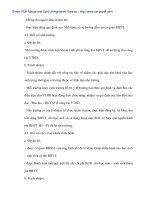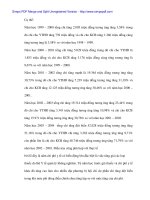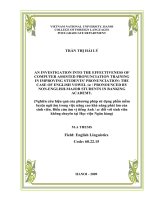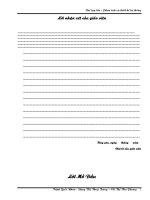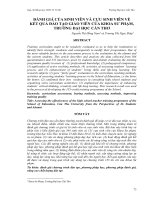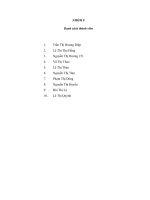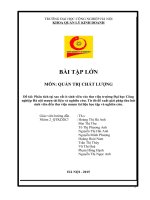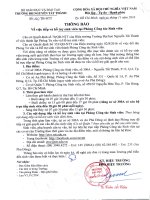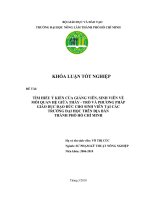Sử dụng phương pháp dạy học hợp tác trong dạy học tiếng Anh nhằm phát triển năng lực ngôn ngữ cho sinh viên
Bạn đang xem bản rút gọn của tài liệu. Xem và tải ngay bản đầy đủ của tài liệu tại đây (496.63 KB, 8 trang )
No.24_December 2021 |p.6-13
TẠP CHÍ KHOA HỌC ĐẠI HỌC TÂN TRÀO
ISSN: 2354 - 1431
/>
APPLICATING COOPERATIVE TEACHING METHODS
IN ENGLISH TEACHING TO DEVELOP STUDENTS’ LANGUAGE ABILITY
Nguyen Thi Thuy Hien1, Nguyen Thi Hong Chuyen2
Tan Trao University
2
Article info
Recieved: 15/9/2021
Accepted: 1/12/2021
Keywords:
application, cooperative
teaching,
English,
language ability, student
Abstract:
The article is based on the theory of the cooperative teaching method such
as: concept, nature, characteristics, meaning to give measures in applying
cooperative teaching method in teaching English to develop students’
language ability such as: choosing appropriate content and tasks; designing
lesson plans based on cooperative teaching method; organizing cooperative
teaching method. From that point, the article asserts: The cooperative
teaching method is the method that plays a very important role in teaching
in general and teaching English to students in particular. Through the way
of organizing teaching, students actively interact with each other. From
there, students will receive knowledge and skills actively and flexibly and
improve their ability to use and apply English fluently in practice.
|125
No.24_December 2021 |p.6-13
TẠP CHÍ KHOA HỌC ĐẠI HỌC TÂN TRÀO
ISSN: 2354 - 1431
/>SỬ DỤNG PHƯƠNG PHÁP DẠY HỌC HỢP TÁC TRONG DẠY HỌC TIẾNG ANH
NHẰM PHÁT TRIỂN NĂNG LỰC NGÔN NGỮ CHO SINH VIÊN
Nguyễn Thị Thuý Hiền1, Nguyễn Thị Hồng Chun2
1
Học viện Chính trị cơng an nhân dân
Trường Đại học Tân Trào
2
Email:
Thơng tin bài viết
Tóm tắt
Ngày nhận bài: 15/9/2021
Bài viết dựa vào lí luận của phương pháp dạy học hợp tác như: khái niệm,
bản chất, đặc điểm, ý nghĩa để đưa ra các biệp pháp trong áp dụng phương
pháp dạy học hợp tác (DHHT) trong dạy học tiếng Anh nhằm phát triển
năng lực ngôn ngữ cho sinh viên như: chọn nội dung và nhiệm vụ phù hợp;
thiết kế kế hoạch bài học áp dụng DHHT; tổ chức DHHT. Từ đó bài viết
khẳng định: Phương pháp DHHT là phương pháp dạy học có vai trị rất quan
trọng trong việc dạy học nói chung và dạy học tiếng Anh cho SV. Thơng qua
cách tổ chức cho SV chủ động, tích cực tương tác nhóm với nhau theo các
pha đảo vị trí. Từ đó, SV sẽ tiếp nhận tri thức, kĩ năng một cách chủ động,
linh hoạt và nâng cao năng lực sử dụng và vận dụng thành thạo tiếng Anh
trong thực tiễn.
Ngày duyệt đăng:
1/12/2021
Từ khóa:
áp dụng, dạy học hợp tác,
tiếng Anh, năng lực ngôn
ngữ, sinh viên.
1. Introduce
Cooperative teaching is the content that includes
both the teaching method of the teacher and the learning
method of the learner. From the teacher’s perspective,
cooperative learning is how the teacher organizes to
transmit knowledge, skills, etc. to the learner. From
the perspective of the learner, cooperative teaching is
cooperative learning between individual the learner
and groups of learners and other objects under the
direction of the teacher. In other words, cooperative
teaching is a form of teaching organization to meet
the purpose and content of the lesson.
2. Content
2.1. Some theoretical issues about cooperative
teaching
According to the Vietnamese Dictionary,
cooperation is „working together to help each other
in a job or a task for a common purpose“[1, p.604].
Cooperation is very important not only to contribute to
the success of any organization or individual but also
to establish relationships in the family and in society.
For the student, cooperative teaching is a form
in which each student will work together in small
groups and groups built according to a clear criterion,
ensuring scientific and suitable for the student’s
ability. Since then, the student learns by doing, not
just by listening.
Within the scope of the article, we are based on
the theory of cooperative teaching and point out some
contents in the application of cooperative teaching
methods in teaching English in order to develop
language ability for students.
126|
Model: Three components of cooperative teaching
No.24_December 2021 |p.6-13
Regarding the essence: cooperative teaching is a
method consisting of 3 components: teacher, learner,
and teaching content. These three components exist
independently of each other, but they interact with
each other and create a dialectical relationship. It can
be illustrated with the following model:
Roles and positions of components of cooperative
learning: 1/ The learner is identified as active subjects
- the center of learning activities. The learner actively
in cooperation with his/her classmate and the teacher
will acquire knowledge on his/her own;
2/ The teacher is the person who guides, organizes,
and controls the self-learning activities of the group
of learners in general and observes each group of
learners, in particular, to help them receive knowledge
appropriate to their own abilities and fastest;
3/ Teaching content is the amount of knowledge
that the teacher determines to provide the learner
during class time.
Regarding the characteristics:
Cooperative teaching has the following contents:
- Regarding the learning task: the learner not only
is acquired the knowledge contained in the program,
but also is focused on developing thinking and
practical skills... in order to meet the requirements of
practical application.
- Regarding the content: The content includes
new knowledge, cognitive exercises in the form of
situations, forms of practice to explore, discover and
solve problems...
- Regarding the method: when organizing
cooperative learning, the teacher focuses on training
the learner the habit of self-learning, independent
individual or collective cooperation through group
discussion and practice.
- Regarding the form of teaching organization: Using
coordination and flexibility of teaching organizations
such as: group - collective, group - individual.
- Regarding the assessment: The learner is
responsible for his/her own learning results.
Therefore, in addition to the assessment of the
teacher, the learner can participate in the process of
self-evaluation and self-assessment of the group.
Regarding the meaning: In the trend of integration
and human-to-human interaction in society, which is
getting bigger and bigger as it is today. Organizing
foreign language learning in general and English
for students, in particular, has become increasingly
important.
This will contribute to the process of knowledge
transmission taking place more and more quickly and
in the direction of “leapfrog over”, making individuals
more active, proactive, and confident in their work.
For higher education in general and English
education for the student in particular, the orientation
to develop the learner’s ability is considered a
requirement for the output standards for students.
Because the ability to practice the profession of
students after graduation must be assessed regularly
and meet the requirements of practice. Since then,
on the one hand, creating conditions for them after
graduation to have a job according to their trained
expertise and have good professional capacity.
Thus, we initially found that using the cooperative
teaching method in teaching English will help
students to be active and excited when performing the
group tasks, but more than that: the student has the
opportunity to promote their existing strengths and
experiences in writing introductions/presentations on
learning contents, etc, and it is a premise for students
to practice introducing/presenting the above contents
through videos made by them.
2.2. Applying cooperative teaching methods in
teaching English to develop the student’s language ability
2.2.1. Choose the right content and task
In order to organize teaching for the student
according to the cooperative teaching method, the
teacher needs to pay attention to the following:
- Time to perform the learning task.
- Group learning tasks are not old or easy theories,
but learning tasks must satisfy one of the following
requirements: new theories to be searched for;
exercises are relatively difficult or very difficult.
The reasons for the above requirements are:
Firstly, working in groups will mobilize many students
to participate. Each student has different experiences,
perceptions, attitudes... in learning. Therefore, it is
necessary to determine the appropriate time;
Second, the group learning contents and tasks
must be new theories or difficult or very difficult
practical exercises to stimulate student’s curiosity.
If the content is too simple, the student will learn
cooperatively which is wasteful and ineffective.
2.2.2. Designing
cooperative teaching
lesson
plans
applying
To ensure the implementation according to
cooperative teaching, it is very important that the
teacher must design lessons and group teaching
activities carefully and in detail. Specifically, when
designing lesson plans, the teacher should pay
attention to the following:
Clearly define criteria for group formation such
|127
No.24_December 2021 |p.6-13
as student’s level; grouping randomly or according to
the student’s forte; or a certain criterion. This depends
on the topics of the lesson and the implementation of
teaching and learning activities.
Identify the main teaching methods: Cooperative
teaching can only be highly successful when applied
with other teaching methods or techniques. For
example, it can be combined with problem detection
and solving methods, experimental methods, puzzle
techniques, etc.
Some techniques for cooperative teaching in
small groups
(1) Technique 1: Assembly (Jigsaw) by Elliot
Aronson
Elliot Aronson’s Jigsaw assembly technique
emphasizes that each student must necessarily rely
on his/her classmate’s information to complete the
lesson task.
They both have to perform their individual
tasks with great responsibility, and also know how
to communicate, listen, and negotiate to come
to an agreement to complete the task with their
classmates in the “expert” group. They also have to
accept the responsibility of being the one to lecture
on the content they have studied to the members of
the “jigsaw puzzle” group. This forces all students
to work actively, avoiding the situation in group
activities where there are active students and
dependent and dependent students. Through working
together, students have the opportunity to develop,
experience, and practice collaborative learning skills
for academic success.
(2) Technique 2: Three-step Interview by Spencer
Kagan
The three-step interview is an effective
collaborative learning technique that encourages
students to share their thoughts and collaborate
with each other. The purpose of this technique is to
facilitate all students to research, share, perform the
group’s learning task, then “teach his/her classmates
again” and be interviewed by his/her classmates
about the content of the presentation. At the same
time, switch roles, listen attentively, share with his/
her classmates when his/her classmates present. From
there, the cases of lazy, dependent and dependent
students are excluded.
(3) Technique 3: Numbered Heads by Spencer
Kagan
This is a technique to create a positive
interdependence relationship in coorperative teaching.
The highlight of this technique is that the student both
works individually with high responsibility to create
128|
individual products, and must know how to negotiate
and exchange with each other to reach a consensus to
create a collective product. group); At the same time,
group members test each other’s comprehension so
that each member can be responsible for presenting
the learning results to the group they create.
Prepare equipment and tools: For each lesson
content and group of students, the teacher needs
to prepare or asks students to have appropriate
equipment and tools. For example, when designing
reading lessons related to the tourist season in
Vietnam, the teacher can ask the student to design
posters introducing each tourist season...
Activities of the teacher and student: This activity
is designed in detail and specifically through two
normative and principled documents: lesson plans
according to standard programs and lesson time
scenarios. Accordingly, the duties of the teacher and
the student are clearly defined in steps.
2.2.3. Cooperative teaching organization
When conducting cooperative teaching to read
texts, the teacher needs to state the tasks, methods
and assessment plans for the whole class. The steps
are as follows:
Firstly, assign the study group and arrange the
group’s activity position in accordance with the
design: accordingly, the structure of each group
will include: group leader, secretary and members.
Based on the task, you can choose different ways of
organizing such as: groups of two students, groups of
three students or groups of more than 4-8 students...
When conducting group discussions, students
sit opposite each other to create interaction in the
learning process. The teacher needs to observe and
promptly adjust so that all members of the group
participate in performing the task.
- Second, assign tasks to each group of students:
depending on the content of the lesson, the teacher
can assign tasks to each group to read a text or read
a text together. When assigning tasks, the teacher
needs to pay attention to the implementation time and
product requirements of each group.
- Third, guide the activities of groups of students:
When groups form and assign, the teacher needs
to clearly mention the role of each group member.
Specifically, the group leader controls group activities;
each student works individually or in pairs, sharing
experiences and discussing and agreeing on the results
of the group; The secretary records the group’s results
and assigns a representative to present the results.
Fourth, the teacher monitors, controls, guides, and
supports groups: in the process of the student’s group
practice, many problems arise and need to be adjusted.
No.24_December 2021 |p.6-13
Therefore, the teacher needs to observe and support
students. When the students conduct discussion and
deviate from the focus or argue without cooperation,
the teacher intervenes in time to orient and adjust the
group’s activities.
method is the lesson containing the required content
to analyze, describe and explain a problem. For
example, these are readings that take advantage of
topics about self-introduction, hobbies, travel, sports,
etc.
- Fifth, the teacher organizes for the student to
report results and evaluate: When the groups have
products, the teacher asks each group to appoint a
representative of the group to report the results and
share experiences with other groups. The teacher
guides the student to listen and give positive feedback.
The goal of the lesson to be achieved is towards
both goals: developing metacognitive capacity in
English reading and cooperative learning skills.
After the student gives feedback, the teacher
closes the basic knowledge and avoids the situation
where the teacher repeats all the problems the students
have presented.
Thus, through the way in which teaching is
organized by the cooperative teaching method, it will
allow teachers to diversify the way they organize
teaching, and the class time becomes more lively,
attractive, and effective in attracting students. At the
same time, the student actively participates in lessons
and improve their ability to use English in practice.
3.2. Using cooperative teaching method in
teaching English reading to students of Political
Academy of the People’s Police of Vietnam
Using Elliot Aronson’s Jigsaw technique to
conduct interactive teaching for students of different
types of reading comprehension on topics related to
ecotourism.
3.2.1. Cooperative teaching combined with
Jigsaw technique in teaching English reading
a) Content
Assembly technique emphasizes that: in the group,
members must have interdependent relationships to
complete the learning task. Therefore, the prerequisite
when applying this technique is: require all students
to work actively and seriously. From there, the
student has the opportunity to develop, experience,
and practice collaborative skills in receiving texts
from word recognition to practice to produce their
own products - confirming academic success.
b) How to do it
Using the interactive teaching method combined
with the Assembly technique in teaching English
reading to students should be carried out in the
following order:
* On the teacher’s side
- The teacher prepares documents related to
teaching from which to select lessons and determine
the content of reading passages that can apply the
above reasoning. Therefore, the content that meets
the requirements of applying this type of teaching
+ Building activity content: based on learning
goals, the teacher selects reading texts that meet 2
requirements: provide the right amount of knowledge
and create thinking challenges and students’ desire to
cooperate to solve problems.
+ Design the assignment sheets: the study sheets
are built specifically and in accordance with the
number of division groups.
Students’ preparation: Master the learned
knowledge and prepare the learning mentality such as
awareness of individual roles and responsibilities in
the group; methods and principles of group activities;
aware of the ability to control oneself in the process
of participating in the discussion…
- Basic steps to conduct the lesson:
+ Step 1: The teacher based on the number of
students in the class and the texts to read to group
students. The rule when grouping needs to follow the
principle: create “warping” between group members.
That is, the members of the group need to have
different qualifications, gender, interests,... Orientation
to advise on assignment of tasks in the group.
+ Step 2: Assign tasks through study cards to each
group of students (it can be a reading or a reading
passage with specific tasks). In this step, the teacher
must clarify the following contents: 1. the tasks of
the worksheets so that all students can visualize and
understand their individual duties and responsibilities;
2. Announce the form and criteria for testing and
evaluating the work progress of each member of the
group and the whole group.
+ Step 3: Student groups receive tasks and
implement them through activities: assigning tasks to
each member of the group; Deploy task analysis and
organize to solve task requirements.
+ Step 4: Split the original group and make the
next group to form “pieces” in the new group.
+ Step 5: The new group performs the task
again and exchanges the lessons learned through
discussion in the original group. In this step, students
are completely confident as well as excited when
presenting and discussing the issues of the passage.
+ Step 6: Test and evaluate.
|129
No.24_December 2021 |p.6-13
The test and evaluation process is conducted by
the teacher in two stages:
Stage 1: observing students practice in groups
when performing tasks.
Stage 2: organizing students take an independent
test.
3.2.2. Example
During practice hours, the teacher organizes
for students to practice reading English through
cooperative teaching combined with Assembly
technique by steps:
Step 1: The teacher prepares study sheets
LEARNING SHEET
A. General information
Name:…………………………….. …….Class:………………………………………….
Subject:………………………………………...Date……………………………………..
Group name:……………………………………………………………………………….
B. Learning tasks
Read the passage and do the tasks:
We are students learning English. We have been studying English here for six months. We study 15
hours a week. We go to class every morning, except Saturday and Sunday. Our class has only 25 students.
We all love learning English. In class, we study very hard and very well.
At first, we had to learn pronunciation. English pronunciation is difficult so the students don’t like it
very much, but we still try to practice pronunciation correctly. Then we learn many things about grammar
and vocabulary. Every week we have a short test on Friday. In class, we practice reading, listening, speaking,
answering, and doing grammar exercises.
Our teacher used to say: English grammar is not difficult but English pronunciation is difficult. Therefore, we must try to practice reading, listening, speaking and spelling a lot.
Questions:
1. Underline words with ending consonants: p, t and c/ch.
……………………………………………………………………………
2. Answer the questions:
2.1 What language are they studying?
…………………………………………………………………….
2.2 How long have they been studying English? What time do they go to class each week?
……………………………………………………………………….……………………………………
2.3. How many students are there in their class? Do they like English?
……………………………………………………………………………………………………………
2.4. At first, what difficulties did they have in learning English? What do they do to overcome the problem?
…………………………………………………………………………………………………
2.5 How is their curriculum?
…………………………………………………………………………………………………
2.6. What do their teachers remind them of when learning English?
……………………………………………………………………………………………………………
Practice asking those questions with your friends.
……………………………………………………………………………………………………………
3. Write a review about your English learning.
……………………………………………………………………………………………………………
Step 2: The teacher divides students into groups.
Based on the number of students, the teacher divides
the class into groups - each group consists of 4
students (this ensures the principle of pairing in the
process of performing the task). The teacher assigns
tasks (study sheets and test sheets for students) and
clearly states the tasks and test methods.
Step 3: Students conduct cooperative learning in
groups that have sequenced activities:
130|
- Divide the group into pairs.
- Split the old couple group and match the new
couple group.
- Split groups and switch members.
- New groups separate from groups to create pairs.
- Pairing groups split up and make new pairs.
Depending on the level of completion of the student,
it is possible to create more Phase 3, Phase 4, etc to help
No.24_December 2021 |p.6-13
students increase their ability to contact and absorb
knowledge as well as practice reading comprehension,
speaking and creating texts by English.
as teamwork skills. This is highly effective in learning
to read English texts. Especially the documents related
to personal feelings and views of students.
The process of students reversing the group
means that students have the ability to adjust their
perceptions with new knowledge (specifically, new
information of students paired with them). This
cognitive adjustment helps students consolidate
existing knowledge, receive new knowledge and
knowledge with the way of critical thinking.
Step 4: The teacher organizes for groups of
students in the final stages to present the results of
their learning tasks.
It can be affirmed that, with the diversity of groups
and the form of pairing, the student has the ability to be
proactive and active in receiving knowledge and at the
same time training for themselves study skills as well
In this step, the teacher pays attention to observe
and listen to the presentations of groups and makes
timely adjustments if the answers are not correct in
terms of: phonetics, spelling, vocabulary, grammar
and intonation.
The teacher gives a sample of general answers for
students to observe:
LEARNING SHEET (Answer)
A. General information
Name: ……………………………..……. Class: ………………………………………….
Subject: ………………………………………...Date: …………………………………….
Group name: ……………………………………………………………………………….
B. Learning tasks
Read the passage and do the tasks:
We are students learning English. We have been studying English here for six months. We study 15
hours a week. We go to class every morning, except Saturday and Sunday. Our class has only 25 students.
We all love learning English. In class, we study very hard and very well.
At first, we had to learn pronunciation. English pronunciation is difficult so the students don’t like it
very much, but we still try to practice pronunciation correctly. Then we learn many things about grammar
and vocabulary. Every week we have a short test on Friday. In class, we practice reading, listening, speaking,
answering, and doing grammar exercises.
Our teacher used to say: English grammar is not difficult but English pronunciation is difficult.
Therefore, we must try to practice reading, listening, speaking and spelling a lot.
Questions:
1. Underline words with ending consonants: p, t and c/ch.
(look at the bold letters in the text shown)
2. Answer the questions:
2.1. What language are they studying?
They are students studying English.
2.2. How long have they been studying English? What time do they go to class each week?
They have been studying English for six months. Each week of study 15 hours on all mornings except
Saturday and Sunday.
2.3. How many students are there in their class? Do they like English?
Their class has 5 students. They all like English.
2.4. At first, what difficulties did they have in learning English? What do they do to overcome the problem?
At first they had difficulty learning English pronunciation. They try to practice pronunciation correctly.
2.5. How is their curriculum?
Every week they have a short test on Friday. In class, they practice reading, listening, speaking, answering,
doing grammar exercises
2.6. What do their teachers remind them of when learning English?
English grammar is not difficult but English pronunciation is difficult. Therefore, we must try to practice
reading, listening, speaking and spelling a lot.
3. Practice asking those questions with your friends.
(Students record their answers in pairs to get more information about you as well as absorb new words
during the pairing interaction.)
4. Write a review about your English learning.
(Depending on students’ feelings. However, it is necessary to rely on samples from the reading passage
and specifically on the questions of requirement 2 to write)
|131
No.24_December 2021 |p.6-13
Step 5: Organize the evaluation of the task
performance of the groups and the writing of each
individual in requirement 3.
3. Conclusion
Cooperative teaching method is a teaching method
that plays a very important role in teaching in general
and teaching English to students. Collaborative
teaching emphasizes the collaborative work between
teacher and student and student with student. These
interactions are in a dialectical relationship with each
other. With characteristics, components, content,...
have multi-dimensional interaction with the presence
of 3 main components: teacher - student - teaching
content.
Through the way of organizing for students to
actively and actively interact in groups with each
other in phase reversal positions. From there, students
will receive knowledge and skills actively and flexibly
132|
and improve their ability to use and apply English
fluently in practice.
References
[1] Institute of Linguistics (2006), Vietnamese Dictionary,
Danang Publishing House, Center for Dictionaries
[2] Michel Develey, Some issues on teacher training,
Vietnam Education Publishing House, 1998
[3] Hung, D.T. (1994), Concept of the development trend of
teaching methods in the world, The Vietnam National
Institute of Education Science, Hanoi
[4] Nghi, P.T. (2011), Textbook of Educational Psychology,
Vietnam National University Press, Hanoi.
[5] Scientific Committee on Social Behavior and Education
(2007), Optimal Learning Methods: Intelligence,
Thinking, Experience and School, General Publishing
House of Ho Chi Minh City.
[6] John Dewey, Anh, V.D translated. (2013), The way we
think, Knowledge Publishing House/
